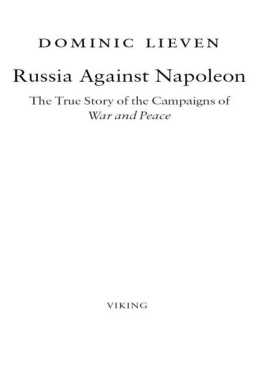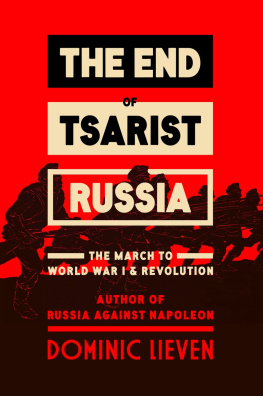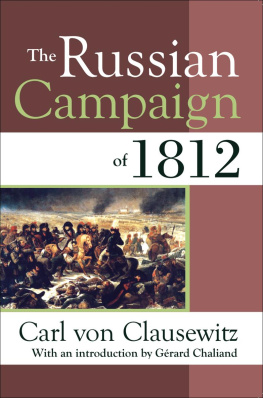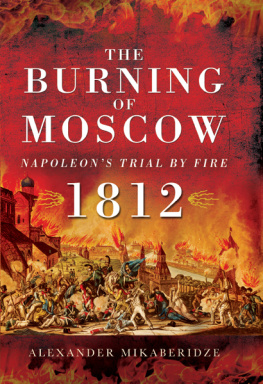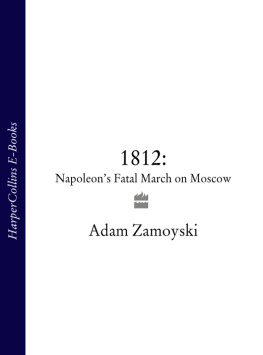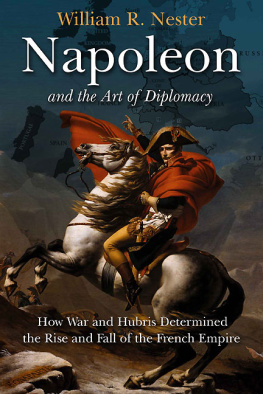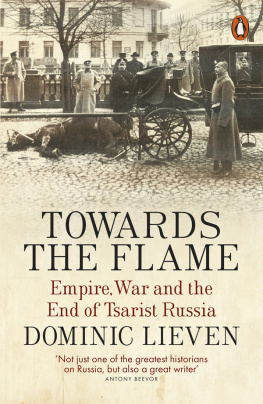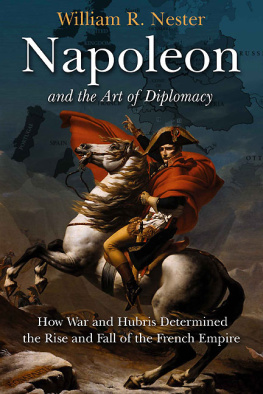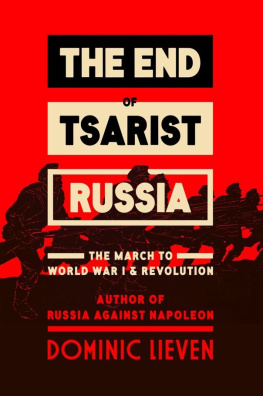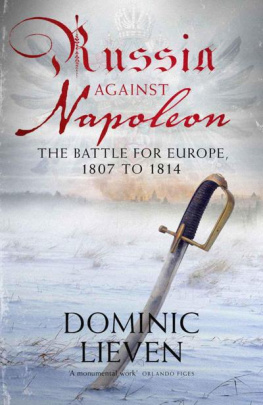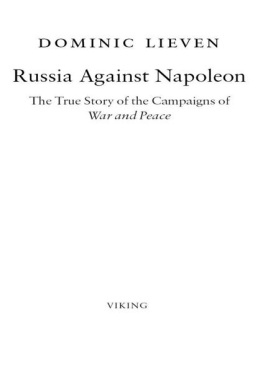Russia Against Napoleon

DOMINIC LIEVEN
Russia Against Napoleon
The True Story of the Campaigns of War and Peace
VIKING
VIKING
Published by the Penguin Group
Penguin Group (USA) Inc., 375 Hudson Street, New York, New York 10014, U.S.A.
Penguin Group (Canada), 90 Eglinton Avenue East, Suite 700, Toronto, Ontario, Canada M4P 2Y3 (a division of Pearson Penguin Canada Inc.)
Penguin Books Ltd, 80 Strand, London WC2R 0RL, England
Penguin Ireland, 25 St. Stephens Green, Dublin 2, Ireland (a division of Penguin Books Ltd)
Penguin Books Australia Ltd, 250 Camberwell Road, Camberwell, Victoria 3124, Australia (a division of Pearson Australia Group Pty Ltd)
Penguin Books India Pvt Ltd, 11 Community Centre, Panchsheel Park, New Delhi 110 017, India
Penguin Group (NZ), 67 Apollo Drive, Rosedale, North Shore 0632, New Zealand (a division of Pearson New Zealand Ltd)
Penguin Books (South Africa) (Pty) Ltd, 24 Sturdee Avenue, Rosebank, Johannesburg 2196, South Africa
Penguin Books Ltd, Registered Offices:
80 Strand, London WC2R 0RL, England
First American edition
Published in 2010 by Viking Penguin,
a member of Penguin Group (USA) Inc.
Copyright Dominic Lieven, 2009
All rights reserved
LIBRARY OF CONGRESS CATALOGING IN PUBLICATION DATA
Lieven, D. C. B.
Russia against Napoleon: the true story of the campaigns of War and Peace / Dominic Lieven.
p. cm.
Includes bibliographical references.
ISBN: 1-101-42938-0
1. Napoleonic Wars, 18001815CampaignsRussia. 2. RussiaHistoryAlexander I, 18011825. 3. Tolstoy, Leo, graf, 18281910. Voina i mir. I. Title.
DC235.L49 2009
940.2'70947dc22
2009042564
Without limiting the rights under copyright reserved above, no part of this publication may be reproduced, stored in or introduced into a retrieval system, or transmitted, in any form or by any means (electronic, mechanical, photocopying, recording or otherwise), without the prior written permission of both the copyright owner and the above publisher of this book.
The scanning, uploading, and distribution of this book via the Internet or via any other means without the permission of the publisher is illegal and punishable by law. Please purchase only authorized electronic editions and do not participate in or encourage electronic piracy of copyrightable materials. Your support of the authors rights is appreciated.
For my courageous wife, Mikiko, and in memory of the regiments of the Imperial Russian Army who fought, suffered and triumphed in the great war of 181214
Contents
Appendix 1:
The Russian Army in June 1812
Appendix 2:
Russian Army Corps at the beginning of the autumn 1813 campaign
Illustrations
Alexander I
Mikhail Barclay de Tolly
Mikhail Kutuzov
Levin von Bennigsen
Peter von Wittgenstein
Petr Rumiantsev
Karl von Nesselrode
Aleksandr Chernyshev
Christoph von Lieven
Mikhail Speransky
Aleksei Arakcheev
Dmitrii Gurev
Fedor Rostopchin
Petr Bagration
Mikhail Miloradovich
Matvei Platov
Eugen of Wrttemberg
Petr Volkonsky
Aleksei Ermolov
Karl von Toll
Johann von Diebitsch
Aleksandre de Langeron
Fabian von der Osten-Sacken
Ilarion Vasilchikov
Johann von Lieven
Aleksei Gorchakov
Dmitrii Lobanov-Rostovsky
Georg Kankrin
Andrei Kologrivov
Private: Preobrazhensky Guards Regiment
Private: Finland Guards Regiment
Private: Riazan Infantry Regiment
Lieutenant: field artillery of the line heavy battery
Private: Ekaterinoslav Cuirassier Regiment
Lieutenant: Guards Dragoon Regiment
Private: Sumi Hussar Regiment
Private: Lithuania Lancer Regiment
Napoleon awards the Lgion dhonneur to Private Lazarev at Tilsit
Borodino: the Raevsky Redoubt after the battle
Spring 1813: the Cossacks in Hamburg
Fre-Champenoise: the Cossack Life Guard Regiment attacks the French infantry
Picture credits:
George Dawe painting, Bridgeman Art Library/Getty Images
Christoph von Lieven: British Library
Aleksei Arakcheev: British Library
Alexandre de Langeron and Fabian von der Osten-Sacken: British Library
Andrei Kologrivov: British Library
Albrecht Adam sketch: AKG Images
V. Bezotosny
Don Cossack Life Guard Club/Courbevoie
Maps
Acknowledgements
So many people and institutions helped me to research and write this book that in normal circumstances it would be difficult to know where to start with my thanks. But the help of one institution, the Leverhulme Trust, was so fundamental that beyond question it must come first. In 2006 I was awarded a Leverhulme Major Research Fellowship, which left me free to work on my book for the next two years and also funded most of my research in the Russian archives. I owe a huge amount to the generous support of the Trust. Professors Paul Bushkovitch, William Fuller and Geoffrey Hosking supported my application for the fellowship, and to them too I owe many thanks.
In the summer of 2006 I had a two-month fellowship from the British Academy which enabled me to work in the Slavic Library in Helsinki. During these two months I was able to read all the regimental histories of Russian units which participated in the Napoleonic Wars. I also read or at least copied all the journal articles published in Russia before 1917 which were relevant to my topic. For any historian of imperial Russia the Helsinki Library is a unique asset, made all the better by the friendly and efficient help of its staff, led by Irina Lukka. My deep thanks are owed not just to Irina but also to Ulla Tillander, who helped so much to organize my expedition and make it pleasant. Richard Stites and the community of historians working in the Library were also very kind to me.
One part of the Russian State Military Historical Archives (RGVIA) holdings on the Napoleonic Wars was microfilmed shortly before I began my research. This is Fond 846, the so-called Voenno-uchenyi Arkhiv (VUA). As anyone looking at my references will see, it contains priceless information for my book. The Librarian of the LSE Library (BLPES), Jean Sykes, and the Librarys main Russian specialist, Graham Camfield, acquired this immensely valuable collection, and left me for ever in their debt.
Even so, the main archival sources for my book had to come from holdings in the Russian State Military Historical Archive (RGVIA) in Moscow other than the VUA. Above all these were the papers of the wartime recruit levies (Fond 1), most of the materials relating to the feeding, equipment and arming of the field armies (Fond 103), the documents of the Reserve Army (Fond 125), and the immensely useful personnel records of Russian regiments (Fond 489). Thanks to Tatiana Iurevna Burmistrova and the staff of RGVIA, I was able to get through all the materials I needed during my six research trips to Moscow.
I would never have been able to do so, however, without the help of Vasili Kashirin. My research was complicated by family needs and by the fact that for part of this time the archive closed for repairs, sometimes with minimal notice. Without Vasilis help in finding materials and ensuring that I received them this book would be much weaker than it is. More than any other individual, he made an enormous contribution to my research. A number of archivists also deserve my special thanks, and not least Aleksandr Kapitonov. Professor Apollon Davidson and his wife Liudmilla kindly put me up in Moscow on a number of occasions and coped with my grumpiness when something went wrong with the archive.

